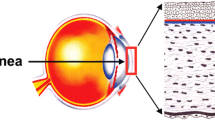Abstract
Collagen types in normal human and keratoconus corneas were separated by salt fractionation and thermal gelation in the pepsin-soluble fraction of the lyophilized tissues. Peptic digestion indicated no significant differences between normal and keratoconus corneas. Further collagen characterization was performed using SDS-PAGE. Collagen concentrations were determined via hydroxyproline. Soluble collagens from normal human cornea represent 85% collagen type I, maximally 10% collagen type III and 5% collagen type V. Soluble collagens of keratoconus corneas consist of 90% type I collagen and maximally 5% type III and type V collagen.
Zusammenfassung
Der Kollagentypengehalt von normalen menschlichen Hornhäuten und von Hornhäuten mit Keratokonus wurde nach Pepsinverdauung mittels fraktionierter Salzfällung und thermischer Gelierung nach Trelstad im lyophilisierten Gewebe bestimmt. Bei der Pepsinverdauung ergaben sich keine signifikanten Unterschiede zwischen Hornhäuten mit Keratokonus und Kontrollen. Die weitere Kollagencharakterisierung erfolgte mit SDS-Polyacrylamidgelelektrophorese. Die Kollagen-Konzentrationen wurden über den Hydroxypolinanteil ermittelt. Das lösliche Kollagen der normalen lyophilisierten Hornhaut ent-halt ungefähr 85% Kollagen Typ I, etwas weniger als 10% Kollagen Typ III und an die 5% Kollagen Typ V. Lösliches Kollagen von Hornhäuten mit Keratokonus bestehen aus ca. 90% Typ I-Kollagen und maximal je 5% Typ III und Typ V-Kollagen.
Similar content being viewed by others
References
Bailey AJ, Sims TJ, Le Lous M, Bazin A (1975) Collagen polymorphism in experimental granulation tissue. Biochem Biophys Res Commun 66: 1160
Burgenson RE, El Adli FA, Kaitila IE, Hollister DW (1976) Fetal membrane collagens: Identification of two new collagen alpha chains. Proc Nat Acad Sci USA 73: 2599
Ehrlich HP, White BS (1981) Identification of A and B Collagen Chains in Hypertrophic scar Exp Mol Pathol 34: 1
Hallermann W, Wilson E (1977) Genetische Betrachtungen über den Keratokonus. Klin Monatsbl Augenheilkd 170: 906
Hammerstein W (1972) Konkordanter Keratokonus bei eineiigen Zwillingen. Ophthalmologica 165: 449
Laemmli WK (1970) Cleavage of structural proteins during the assembly of the head of bacteriophage T 4. Nature 227: 680
Newsome DA, Foidart JM, Hassell JR, Krachmer JH, Rodrigues MM, Katz SK (1981) Detection of specific collagen types in normal and keratoconus corneas. Invest Ophthalmol Vis Sci 20: 738
Robertson I (1975) Keratoconus and the Ehlers-Danlos syndrome. A new aspect of keratoconus. Med J Aust 1: 571
Sage H, Pritzl P, Bornstein P (1981) Characterization of cell matrix-associated collagens synthesized by aortic endothelial cells in culture. Biochemistry 20: 436
Stegemann H, Stalder K (1967) Determination of hydroxyproline. Clin Chim Acta 18: 267
Stoesser TR, Church RL, Brown SI (1978) Partial characterization of human collagen and procollagen secreted by human corneal stromal fibroblasts in cell culture. Invest Ophthalmol Vis Sci 17: 246
Yue BYJT, Baum JL, Smith BD (1979) Collagen synthesis by cultures of stromal cells from normal human and keratoconus corneas. Biochem Biophys Res Commun 86: 465
Author information
Authors and Affiliations
Rights and permissions
About this article
Cite this article
Radda, T.M., Menzel, E.J., Freyler, H. et al. Collagen types in keratoconus. Graefe's Arch Clin Exp Ophthalmol 218, 262–264 (1982). https://doi.org/10.1007/BF02175894
Received:
Issue Date:
DOI: https://doi.org/10.1007/BF02175894




